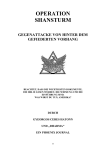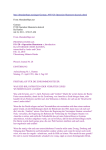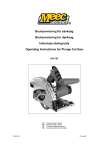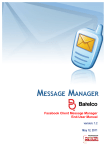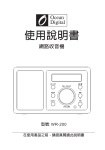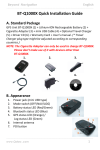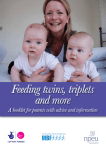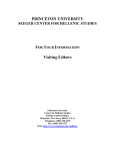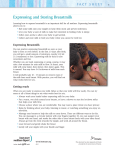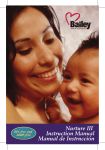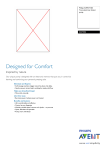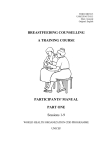Download Breastfeeding Guide - Feeding your Baby
Transcript
Welcome to Hillingdon Hospital! Feeding Your Baby This folder is the property of The Hillingdon Hospitals NHS Foundation Trust Developed by, Kelly Kinsella Infant Feeding Co-ordinator and Kasia Willaims Breastfeeding Support Worker Contents Breastfeeding 1 2 3 4 5-7 8 9 10 11 12 13 14 15 16 17 - 19 20 21 22 - 23 24 25 26 27 - 28 29 30 Benefits of breastfeeding Breastfeeding timeline Skin to skin Size of baby’s stomach Positioning and Attachment How do I know my baby is hungry? Different feeding positions Colostrum - your first milk Is my baby getting enough? Sleepy, reluctant feeders Baby led feeding Does giving formula make a difference? Co-sleeping Hospital beds Expressing breast milk Storing breast milk Cup Feeding and syringe feeding Breastfeeding and the Neonatal unit Teats and dummies Advice for partners Going back to work Breastfeeding problems Where to get extra help Bump to breastfeeding DVD Formula feeding 31 32 33 34 35 36 Making up a formula feed Key facts about formula Types of formula milk Skin to skin Baby led feeding Reasons for good hygiene With thanks to the Baby Friendly Initiative The benefits of breastfeeding Mums are less likely to have: • • • • Breast cancer Ovarian cancer Osteoporosis and hip fractures in later life Can also help with weight loss Babies are less likely to have: • • • • • • • 1 Gastronentiritis, diarrhoea and vomiting Urinary tract infections Chest infections Ear infections Type 2 Diabetes Obesity Allergies such as asthma and eczema Breastfeeding timeline At Birth When baby is born start skin to skin (see page 3) and keep it going for at least an hour or until baby has their first feed. Your midwife will help you with the first feed Skin to skin Golden Hour 12 hours If baby has not fed yet, continue to hand express and offer baby droplets of colostrum (see page 10) every 2 - 3 hours 1 hour If baby has not fed, keep skin to skin going for the next 6 hours Learn how to hand express - see pages 17 - 19 6 hours A midwife will offer you support with the second breastfeed. If baby has not fed yet then continue with skin to skin. Start hand expressing and give baby your colostrum 3- 4 days 24 hours Has baby had at least 3 feeds? Has baby done 1 or 2 poos and 1 or 2 wees yet? If not ask a midwife for help. From now on baby will feed at least 8 times in 24 hours Look for poos and wees! Watch baby for swallowing Colostrum comes in small amounts. Around day 3 or 4 your supply may increase and become more milky looking. Watch out for engorgement (see page 27-28) 2 weeks It takes 2 weeks to reach mature milk so it’s really important to build up your supply in this time 6 months Around this time begin introducing solid food 1 year + Breastfeeding benefits your baby up to and beyond 2 years of age. You can breastfeed for as long as you wish 5 days Baby’s poo should be yellow by now. If not ask a midwife for help 2 Skin to Skin helps with. . . • Bonding • Keeping your baby warm • Regulating your baby’s breathing and heartbeat • Keeping your baby calm • Breastfeeding 3 Swaddling baby in a cot makes it harder to see when your baby is hungry Size of baby’s stomach This is the size of a baby’s stomach: 24 hours old (5 - 7 mls) At least 3 feeds in the first 24 hours 3 - 5 days old (22 - 27 mls) Your baby should be feeding a minimum of 8 feeds in 24 hours from day 2 10 - 12 days old (60 - 85 mls) 4 Positioning 5 • Baby’s head and body are straight. • Baby’s back and shoulders are supported. • Baby can move head back. • Mum is comfortable • Nose to nipple. • Lead with the chin Attachment Mouth is wide open and chin is tucked closely into the breast His cheeks are full and rounded. More areola is visible above the baby’s mouth than below. Sucking pattern changes from rapid sucks to big deep sucks with pauses and swallows. You can hear or see swallows. Sucking is not painful—if it is then put your little finger in baby’s mouth to take them off. 6 Why is attachment and positioning important? • • • • • You won’t get sore nipples You and baby will feel comfortable during feeds Baby will be able to get the right amount Baby will be happy and satisfied after feeds Your breasts will keep making enough milk 7 How do I know if my baby is hungry? These are all signs that baby is hungry. Watch for early feeding signals: • • • • • • • 8 Rooting. Wriggling. Sucking or licking hands or fingers. Rolling eyes. Moving head from side to side. Opening and closing mouth. Crying is the last sign of hunger. Feed baby before she cries as this will make breastfeeding easier and she will be happier. Different feeding positions Cradle Hold Rugby Hold Side Lying With a baby sling you can breastfeed hands free! 9 Colostrum - your first milk Colostrum is the first milk you have. It is made in small amounts and very important for your baby’s de- Colostrum 10 Changing milk Mature milk • Colostrum is concentrated breast milk. • It can be yellow/gold in appearance. • It is rich in antibodies. • Clears meconium and helps to reduce jaundice. • Has a laxative effect, which helps your baby poo. Is my baby getting enough? Signs to look for: • Allow your baby to come off when he’s ready. • You can see or hear baby swallowing. • Baby is doing wees and poss each day. • Baby feeds for 5—40 minutes each feed. • Baby feeds at least 3 or 4 times in the first 24 hours • Baby feeds at least 8 times a day from day 2 onwards • You are offering baby both breasts each feed. 11 Sleepy, reluctant feeders Wake your baby to feed • Aim for at least 10 - 12 times in 24 hours Skin to skin is very important • Keep your baby in skin to skin contact - this will help increase your milk supply and encourage baby to feed Hand express every 2 hours • • 12 You can hand express colostrum into a syringe and give it to your baby (see pages 17 - 19 for help with expressing). This will encourage your baby to feed Baby led feeding This means feeding baby whenever they want and as much as they want. Baby led feeding ensures: • Baby will get all the milk they need • Baby will cry less and be happier • Your breasts will produce enough milk and won’t become engorged • Baby will gain weight well • Keeping you and baby together 24 hours a day is important for successful feeding Baby led feeding will also help with: • Bonding • Learning when baby is hungry (see page 8). 13 Does giving my baby formula milk make a difference? Yes it does 14 • Breastfeeding works on a supply and demand basis. If baby led feeding is interrupted by giving formula your breasts may not make enough milk for your baby. • Yours breasts can become full and uncomfortable. • If baby does not feed frequently it can be more difficult for baby to attach to the breast. • Babies given large amounts of formula may be less satisfied with ongoing breastfeeds. • Breastmilk provides a protective coating in baby's digestive tract and formula milk can destroy this. • Babies who suck on a bottle teat may find it more difficult to breastfeed. This is called nipple confusion. • Offering formula as a night time feed will reduce your milk supply. Co-sleeping Babies need physical contact with their mothers and many families find sharing a bed with their baby is the best thing to do. Babies feed frequently at night and sharing a bed can make breastfeeding easier. Breastfeeding mothers naturally adopt a safe position curved around baby Important advice for sleeping with your baby: • You and your partner must not smoke, drink alcohol • • • • • 15 or use drugs You must not be taking medication that makes you sleepy You should be breastfeeding not bottle feeding Keep covers and pillows away from baby Only sleep in a bed - do not sleep on a sofa Ask staff for help and a leaflet Hospital beds Babies can fall off the bed. • If you are tired or taking medication you may be sleepy • Hospital beds are more narrow and higher than beds at home • Hospital floors are also very hard • If you are having skin to skin or sleeping with your baby in the hospital bed, you must make sure baby cannot fall on the floor. Please make sure your baby is safe. 16 Expressing breast milk If your baby is sleepy or you are not able to breastfeed because baby is on the neonatal ward it is really important to start expressing your milk. This will make sure you have a good milk supply. • In the first 2 or 3 days colostrum is produced in small amounts so it is easier to express by hand • Collect the colostrum in a syringe or a cup • Start expressing within 6 hours of your baby being born • Hand express at least 8 times in 24 hours • After the first 2 or 3 days you will have more milk and you can try using a pump which can make expressing easier 17 Hand expressing When milk stops flowing, rotate your fingers and thumb to a new position and continue until the milk stops. Then you can start from the beginning again. 18 Breast pumps Breast pumps are used to help you express milk for your baby if you temporarily cannot breastfeed. • Pump each breast until the flow of milk stops, then you can do more hand massage and apply the pump again • You can pump both breasts at the same time (double pumping) • Pump at least 8 times in 24 hours • If you need to produce more milk you can increase your milk supply by expressing after every feed for 24 to 48 hours 19 Storing breast milk Ensure that the milk is placed at the back on the lower shelf of the fridge. Milk stored in the door will increase in temperature each time the door is opened, this can encourage bacteria. You can label the breast milk with a time and date. Place Maximum Time Fresh breastmilk Room 6 Hours Fridge 5 - 10°C 3 Days Fridge 0 - 4 °C 8 Days If the temperature rises above 4°C after 3 days, use within 6 hours or throw away) Freezer - 18°C or lower 6 months Previously frozen breastmilk Defrosted in fridge 12 hours Defrosted outside fridge Use immediately Source Breastfeeding Network 20 Neonatal unit • If your baby is on the neonatal unit you may need to express your breast milk for them. • It is best to have your baby with you when you do this as this starts your milk flowing. • If you can’t have baby with you keep a photo or item of baby’s clothing with you. Looking at these and thinking of baby can help your milk to flow. (See diagrams on the following page). • Ask staff for help with skin to skin contact with your baby. This will stimulate your milk supply. 21 Cup feeding and Syringe feeding 21 • If your baby needs to feed and wont attach to the breast then cup feeding or syringe feeding can be recommended. • You can hand express your colostrum into 1 ml syringe and give it to your baby. • These methods help to avoid confusion between nipple and teat. • They are short term solutions only, if you are having difficulty with attaching baby to the breast in the early days. • Please ask a member of staff to show you how to cup feed or syringe feed safely. Breastfeeding and the neonatal unit • If your baby is on the neonatal unit you may need to express your breastmilk • It is best to have your baby with you when you do this as this starts your milk flowing. • If you cant have baby with you keep a photo or item of baby's clothing with you. Looking at these and thinking of baby can help your milk to flow. • Ask staff for help with skin to skin contact with your baby as this will also stimulate your milk supply. 22 22 Teats and dummies Try not to use teats and dummies in the first 4 - 5 weeks of breastfeeding. • • • • • They interfere with suckling. Baby might find it more difficult to attach to the breast (sometimes called nipple confusion). Baby will suckle less at the breast which may mean you produce less milk You may have problems such as engorgement and mastitis (see page 27-28). It is more difficult to establish breastfeeding and breastfeeding is more likely to stop earlier. 24 Advice for partners Partners play a key role in breastfeeding. You can help by making sure mum is comfortable and eating and drinking well. You can be part of the feeding process by sitting with mum while baby feeds and enjoying being together. Different ways partners can bond with baby: • • • • Give baby a bath. Change baby’s nappy. Have skin to skin contact. Talk to baby and sing songs—this is vital for baby's development. • Give baby a massage • Wear baby in a sling and go to the shops or friends houses. 25 Going back to work You don’t have to stop breastfeeding because you are going back to work. • Ask staff for a leaflet. • Employers have obligations to• • • • • • • wards breastfeeding women. Tell your employer in writing in advance so that they can prepare. Arrange childcare nearby so you can feed in breaks. Express your milk so your baby’s carers can feed baby while you are at work/or if your near by you can feed your baby. Ask your employer about flexible hours Express milk at work - practice beforehand! Build up a store of milk at home in the freezer Read the ‘Breastfeeding and Work’ leaflet and show it to your employer. 26 Having problems? ...sore nipples? ...baby having difficulty feeding? ...engorgement? ...mastitis or thrush? • • • Check positioning and attachment Keep nipples moist with breastmilk Keep baby skin to skin Most importantly get support from your midwife or local breastfeeding support group. 27 Mastitis, thrush and engorgement Normal breasts are: • Warm • Soft • Comfortable • Milk flows easily Engorged breasts are hot, hard and painful and difficult for baby to feed from: • Check attachment • Hand massage & express • Hot flannels or a warm bath Thrush is itchy, sore, pink, shiny, burning or continually cracked nipples or breast pain • Continue to breastfeed • Seek medical advice Mastitis causes red patches, pain and may be infected • Continue to breastfeed • Seek medical advice 28 Where can I get extra help? Are you aware of local breastfeeding groups? The breastfeeding support groups have fantastic, trained volunteers on hand to help and you don’t need to make an appointment, you can just drop in. You will be given a leaflet when you go home with details of when and where the groups are. Other contacts that you may find helpful: • Hillingdon Hospital Infant Feeding Team 01895 279 723 • UNICEF Baby Friendly website www.babyfriendly.org.uk • NCT Breastfeeding helpline 0300 3300 771 • Breastfeeding Network 0300 100 0210 • National Breastfeeding Helpline 0300 100 0212 • La Leche League 0845 120 2918 30 From Bump to Breastfeeding A DVD made by Best Beginnings, a charity working to give every baby in the UK the healthiest start. It is a fantastic DVD all about breastfeeding and follows real mothers’ stories and gives you practical advice to follow. Please ask a member of staff for a copy or you can visit the website www.bestbeginnings.org.uk and watch the DVD online. 30 Making up a formula feed Step 1 Fill the kettle with at least 1 litre of fresh tap water (don’t use water that has been boiled before). Step 2 Boil the water. Then leave the water to cool for no more than 30 minutes so that it remains at a temperature of at least 70°C. Step 3 Clean and disinfect the surface you are going to use. Step 4 It’s really important that you wash your hands. Step 5 If you are using cold water steriliser, shake off any excess solution from the bottle and the teat, or rinse the bottle with cooled boiled water from the kettle (not the tap). Step 6 Stand the bottle on a clean surface. Step 7 Keep the teat and cap on the upturned lid of the steriliser. Avoid putting them on the work surface. Step 8 Follow the manufacturer’s instructions and pour the correct amount of water that you need into the bottle. Double check that the water level is correct. Step 9 Loosely fill the scoop with formula - according to the manufacturer’s instructions - and level it off using either the flat edge of a clean, dry knife or the leveller provided. Step 10 Holding the edge of the teat, put it on the bottle. Then screw the retaining ring onto the bottle. Step 11 Cover the teat with the cap and shake the bottle until the powder is dissolved. 31 Key facts about formula 1. Make up feeds one at a time, as your baby needs them 3. Always put the water in the bottle first, while it is still hot, before adding the powder 5. Different types of formula come with different scoops. Only use the scoop enclosed with the formula you are using 2. Always use boiled water at a temperature of at least 70C, but remember to let it cool before giving it to baby 4. Always use freshly boiled water 6. Never warm up formula in the microwave as it can heat the feed unevenly and burn 32 Types of formula milk Please ask staff for the Department of Health ‘Guide to Bottle Feeding’ leaflet. 33 • There is no independent research which finds that any brand is better than another. It is ok to buy the cheapest if you want to. • It is important that you buy milk that is right for your baby’s age. If they have milk meant for an older baby they may become unwell. • Formula is mostly whey based. Some companies make casein based formula sometimes called ‘hungry baby’ formula. There is no evidence this type of formula helps babies to settle better and there is little difference between this and standard formula. • Follow-on formula should never be fed to a baby under 6 months old and research has shown it has no clear benefit. • Ready made formula in a carton or jar is already sterile and does not need to be heated up. Powdered formula Skin to Skin with formula baby Swaddling baby in a cot can make it more difficult to see when baby is hungry • Give baby lots of skin to skin contact. This will help baby to be calm. It will regulate baby’s breathing, heart rate and body temperature and helps the bonding process too. • Skin to skin helps to nurture baby, who has less contact with you when wrapped up in a cot. • If baby does not want a full feed but remains unset- tled they may want comforting with skin to skin. 34 Baby led feeding This means feeding baby whenever he wants and as much as he wants. • Baby led feeding makes sure your baby will get the milk he needs. • Baby will cry less and gain weight well. • It also helps you bond with baby and learn when baby is hungry (see feeding cues on page 8). • Babies have very small stomachs when they are born (see page 4). • Manufacturers instructions can be used as a rough guide but baby should be allowed to decide when he has had enough. • Evidence shows that it is best for mums to feed baby es- pecially in the early days. When feeding baby keep her close and look into her eyes so she feels safe and loved and learns about you. 35 Reasons for good hygiene Powered infant formula is not sterile • • • • Any milk left in a bottle after baby has fed should be thrown away. Powdered formula can contain Salmonella or other bacteria which can cause life threatening illness. It is necessary to kill the harmful bacteria with heat of at least 70C.(boil water, then leave no more then 30 minutes. Any unused made-up formula should be thrown away after 2 hours in room temperature. Made-up formula can be cooled and stored in the fridge for up to 24 hours or can be cooled and stored with an icepack for 4 hours. Ready made milk in a carton is sterile • • It must be used within an hour of opening if kept at room temperature. It can be stored in the fridge for 24 hours with the cut corner turned down. After this time it should be thrown away. 36 Alternative Formats and Languages Please call PALS (Patient Advice and Liaison Service) if you require this information in other languages, large print or audio format, on 01895 279973. Fadlan waydii haddii aad warbixintan ku rabto luqad ama hab kale. Fadlan la xidhiidh 01895 279 973 Jezeli chcialbys uzyskac te informacje w innym języku lub w duzej czcionce popros pracownika oddzialu o kontakt pod numerem telefonu: 01895 279973 各國語言/模式選擇 若你需要以下資料改為其他語言,大寫,或其他模式例如收音式或 盲人字體的話,請電 01895 279973。 37








































